Article in ‘Le Journal de la Mécanisation Forestière’
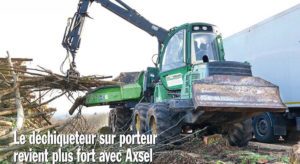
A driver’s cab like no other…
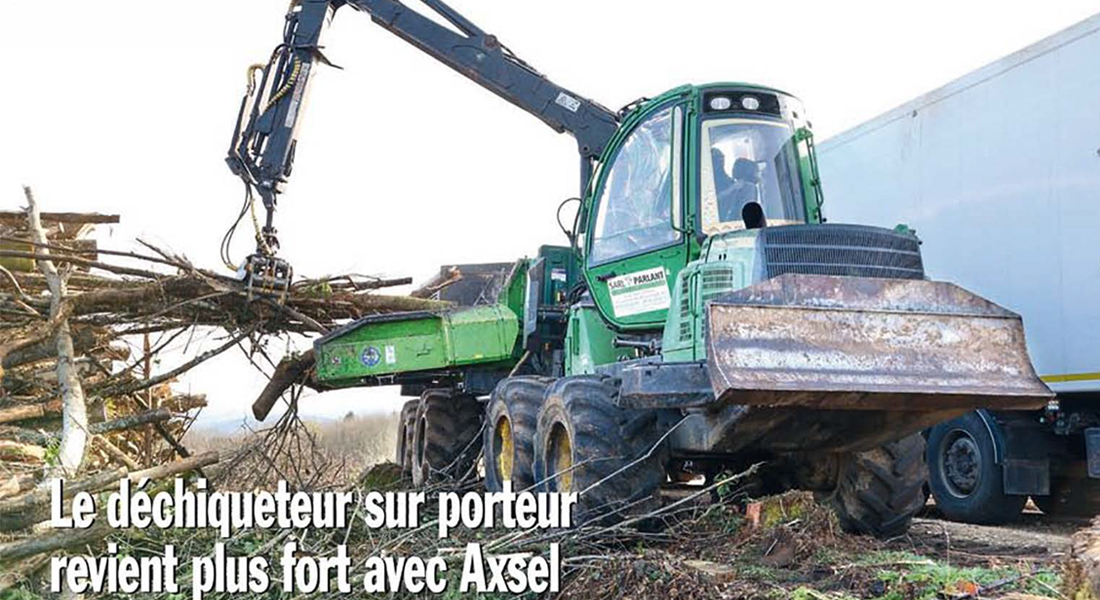
The truck-mounted chipper makes a comeback with Axsel
Philippe Parlant is a good example of how to upscale within the same company. This logger from Corrèze has been involved in processing wood for biomass energy since 2010 and sets great store by continuity to power his business into the future. By opting for a chipper from Axsel (the new name for Dutch Dragon) on a John Deere forwarder, all powered by Afco, he has come up with an original configuration to ensure a truly agile approach to production and logistics.
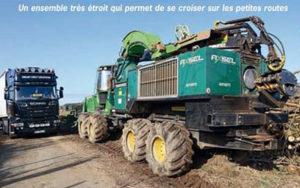
Very narrow vehicles, allowing them to pass on minor roads.
INCORPORATING BIOMASS WOOD INTO OTHER OPERATIONS
As our interviewee explains, “there is growing demand for biomass energy from wood”. This is a good thing because it ties in neatly with increased demand for chipping from highways and environment departments. Will this start a virtuous circle? Whether or not it does, more and more biomass heating plants are being brought online and are gradually gaining in importance in the region. Philippe Parlant is also in favour of this new form of energy for another reason. “It clears the logging sites beautifully, too,” he explains. No more coppices or waste wood left on the ground are plus points for the owner and the standard of work.
He certainly has no regrets about incorporating biomass wood into his business. Production has currently hit around 14,500 tonnes per year, with a realistic long-term aim of 18,000 tonnes. He would have to invest in a forwarder and a harvester to move to the next level, a step which is definitely not on the cards at present. Nor does he regret partnering with Afco for his production equipment. Quite the contrary: he is at pains to stress that “Afco’s support is critical” for his equipment investment programme. He has used John Deere’s distributor for the west central region of France for his operating equipment for the past 26 years – starting with a Cernet, followed by a 1210 forwarder. “At the time I was only doing logging”, Philippe recalls. As so often happens, faced with a lack of lumberjacks, he bought his first harvester in 1999, a few months before the great storm. He moved into logging when prices for services collapsed in 2003-2004. Initially, competition in the region was very tough, but Philippe gradually found his niche with some very big buyers. He expanded his equipment fleet on a regular basis to meet customers’ demands and included chipping in 2012, once again assisted and advised by Afco.
His first Dutch Dragon chipper arrived mounted on a semi-trailer. At the time, he thought this would be easier to move. Then, on his first roadside sites with verges, this configuration proved to be unsuitable for access and loading. As the cost of transportation by trailers was very high and technically quite unsatisfactory, he took the decision to mount the chipper on the same forwarder used to supply and feed it, an 810. Philippe acknowledges that the solution was so satisfactory that “it remained in place for seven years”.
A forwarder can cross over to go and chip wood stacks on platforms whatever the external conditions. It has a powerful crane and can be moved quite easily. These are essential qualities given the lack of storage sites in the Limousin region. As with other operating equipment, the forwarder is moved by flat-bed trailer to optimise flows. And there is always the advantage that it returns unladen to make its deliveries. On the other hand, with its own lorries, the company can supply its customers with chips just in time. It is, therefore, equally important that the chipper can always be positioned next to wood stacks, without the need to move the material to a chipping and storage area.
SECOND-HAND FORWARDER AND NEW CHIPPER
The previous chipper had a lifespan of 5,000 hours before it had to be replaced. “It was basic and effective”, as its driver for seven years, Gaëtan Garreloup, puts it. It was not necessarily a question of changing brand. Dutch Dragon had been bought by Hencon, a company that markets chippers under the Axsel brand, but the fundamental requirements had not changed. In Philippe’s opinion “It is the same machine”, in both its concept and design. Afco therefore proposed a logical solution by mounting an Axsel chipper on a second-hand Series E forwarder, which immediately won over our loggers. Putting a bigger chipper on the 810 which carried its predecessor did not seem to be a good idea, either in terms of cranes or mobility. However, the rotating cab is perfect for supervising chipper loading operations. They therefore chose a 1110 E as the base. Even so, there was no question of mounting the chipper on a new forwarder, which would have been too expensive just for producing chips. What they needed was a high-quality second-hand forwarder. Fabien had one for sale for €110,000 for a 1110 E. “It was the best compromise, with good mobility and clearance,” Gaëtan agreed. It can be used in the woods and on road verges alongside the trailer. As examples go, these suggestions from our Corrèze driver to justify mounting on a truck are eloquent and hard to beat. As the chipper weighs around 14 tonnes, it requires a forwarder like the 1110 E to be both stable and powerful enough to move it.
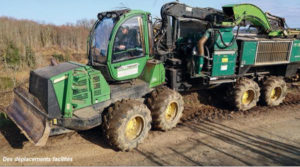
Easy transportation
HAPPINESS IS A CHIPPER-FORWARDER
The new AX10075 already had 800 hours under its belt at the start of this year, after just 10 months’ use. The machine spews chips at full speed into the moving floor trailer firmly attached to its side. The road is extremely narrow, but the two machines are able to travel in parallel without any difficulty, thanks to the slimline forwarder which carries the chipper within the same gauge. The 1110 E forwarder is halfway in the ditch, at the limit of the camber, but this does not worry Gaëtan, who processes loads one after the other. Most of the time, the material used to make chips is rotting sweet chestnut and leftover wood from sawing and site clearance. The driver can collect wood right underneath his own position, from the bottom of the wood stacked beside the road, then easily pick it up using the crane. He makes good use of the crane’s length thanks to rakes which protect the hoses. The chipper is voracious. As soon as the grab brings a pile of wood, it is seized and not a single log escapes the compression roller, even when presented sideways. “When it bites, it doesn’t let go,” the operator explains. There is very little dust outside the chipper or in the final shavings, just 3% on average, although the lack of a screening grid means there may be a few more end pieces. It is up to the driver to feed these into the chipper regularly.
In go sweet chestnut mixed with walnut, with quite large crowns, but they are just a mouthful to the AX10075. The 760 bhp Volvo engine roars. The crane provides increased height and makes it possible to take bigger trees, even whole crowns, without strain. “It is incredibly comfortable to drive,” smiles Gaëtan. “It is a real chipper cab,” he adds. It is true that the cab provides a really comfortable workplace, both in terms of insulation, seating and visibility. The machine is also very stable, which assists the speed at which the crane can be operated. The levelling feature isn’t just another gimmick either; it is a system that is used regularly to keep the driver’s seat level while the chipper is being filled. It is very easy to see the feed belt up to the first roller from the forwarder seat. It is now much closer and higher than on the 810, the perfect position for effective, fast loading. Positioning of the lights has also improved, with two side lights and one on the chute with the camera, as well as the cab’s own lights.
The forwarder advances as its chips; it adjusts to the wagon fill level. The lorry no longer needs to move and the forwarder performs this manoeuvre automatically. The only minor downside is that when it can only discharge backwards, the Axsel does not completely reach the other end of the trailer wagon. According to Gaëtan, this is a typical site – the lorry has to leave the way it came in, without moving off the side of the tarmacked road. But this is not a problem for him; he can go almost anywhere he wants. The same applies to the chips, which can more or less be produced on demand, from a grain size of 30 for just 40 per week supplied, up to G100, but G45 is the size most commonly requested. The chips are calibrated simply by adjusting the feed speed.
Performance is measured at the bottom of the trailer. Loads occur on average every 30-45 minutes. The average time is maintained – around 40 minutes to load this trailer.
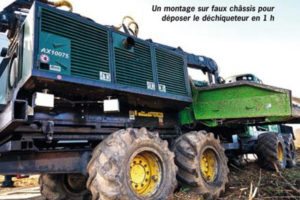
Mounting on a subframe to position the chipper in 1 hour.
MORE EFFICIENT AND ECONOMIC
The Axsel chipper can be unloaded by two people in one hour and can be put on four stands. There is only one cable bundle to be disconnected. The subframe specific to the forwarder has a very simple design and the keyed hooks are designed specifically for John Deere machinery. Afco was able to adapt these to match its customer’s needs, based on advice from the manufacturer, who remained highly involved throughout. It is the first of its type to be supplied to Europe, which is not surprising. This chipper has a 1,000 mm diameter drum, with a feed capacity of 1,000 x 750 mm. It is driven by a tensioned hydraulic belt at a rotation speed of 1,000 rpm. The counter-rotating blades, two fixed and one moving, make it possible to adjust initial chipping operations. The AX10075’s main strength is the pressure exerted by its upper roller, which has an in feed force of about six tonnes. The feed rollers and the compression roller have offset spikes to centre the material in the middle of the belt. The three lower rollers are the most useful, the fourth only coming into play when there are long lengths of wood.
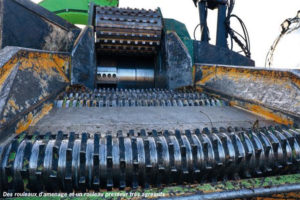
Very aggressive feed rollers and a compression roller.
The belt itself has got longer over time, which is also good, as it means that in future the driver will be able to chain up the grabs more quickly. At the same time, the directional chute is also longer at the end after the articulation point. The chute’s wearing parts are made from stainless steel.
At present, its fuel consumption averages 41.4 l/hour, with production fluctuating between 180 and 200 m3/hour. This is real progress compared with the previous model, which was undoubtedly smaller, at 60 x 60, but which still used around 33 litres in return for 90 m3 in 45 minutes. This is a huge improvement in time and consumption. Remember that the 730-litre tank means that the chipper can work for a full day without stopping. Although the chipper’s power has doubled, its increased yield makes it worthwhile. There have also been a number of other advances, such as evacuation of the fines from the chute by injecting air into the mill’s bearings, or mill deflectors. The Hardox 400 partitions are also now thicker and airtight, which means that dust can no longer reach the belts. The movable ramp increases safety when accessing areas towards the top of the machine, and changing the blades is also safer. This is significant progress, since the set of three blades only lasts around 10 hours.
The Axsel chipper is clearly particularly well suited to mounting on a forwarder. Around 20 years ago, Scandinavian practice and the lack of French experience in biomass wood harvesting tended to suggest that biomass wood pioneers should mount chippers on forwarders. However, this led to inconclusive results at the time, with the various disadvantages of chippers and forwarders working against one another. The market swung towards lorries and self-propelling chippers instead. It seems, however that the time is now ripe for forwarders, with the Axsel chipper, to take the lead in the biomass wood scene once again.
S.A.
TECHNICAL DATA
AX10075 CHIPPER
- Feed: 1,000 x 750 mm
- Belt length: 2,171 mm
- 4 lower drive rollers
- 1 upper drive roller – 6 tonnes in feed force
- Rotor: 1,000 mm diameter
- 3 blades
3 counter-rotating blades
1,000 rpm
- Volvo Penta 6-cylinder engine, 760 bhp
- Weight: 14,000 kg
Source/citation: Journal Mécanisation Forestière / Février 2020)